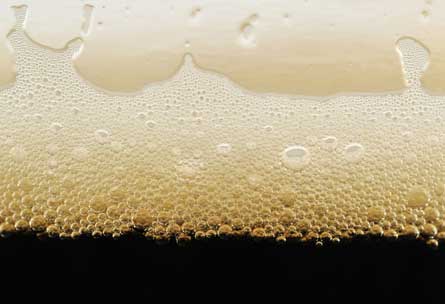This St. Patrick’s Day, raise a glass to the beer researchers of Ireland. By figuring out how bubbles form in stout beers, a team of mathematicians has come up with an idea that could better unleash the foamy head of Guinness: beer cans lined with a material similar to a coffee filter.

Stout beers foam less than other beers when poured, thanks to the nitrogen gas that brewers inject into the liquid before packaging. Nitrogen cuts down on acidic tastes and provides a longer-lasting head and a creamier mouthfeel, owing to the small size of its bubbles. But nitrogen doesn’t dissolve as well as other gases or form bubbles as easily. That’s why bars need special devices to force the bubbles out of tapped stout beers and why every can of Guinness contains a hollow ball filled with nitrogen gas that triggers foaming. It’s also why beer aficionados in search of a foamy head spend 30 seconds on the perfect pour.
Carbon dioxide, present only in small quantities in stouts, gives a quick fizz and foam to soft drinks, champagne and paler beers. Pour a bottle of one of these carbonated beverages, and the gas readily comes out of the liquid. Bubbles speedily form and grow larger while rising through the liquid, adsorbing gas and releasing it at the surface.
To see if stout beers could learn a thing or two from lighter beers, mathematician William Lee of the University of Limerick and colleagues investigated the mechanism behind bubble formation.
In a glass of beer, bubbles form only at the sides and bottom — not within the beer itself. Trapped pockets of gas create steady streams of these bubbles much in the same way that dropping sugar crystals into an overly sweet — what chemists call supersatured — sugar solution creates rock candy. Irregularities in the glass itself were once thought to be the origins of these pockets of gas.
But in 2002 Gérard Liger-Belair, a chemical physicist at the University of Reims Champagne-Ardenne in France, proposed that gas pockets in bits of fibrous material clinging to the sides of containers were actually driving the formation of bubbles in carbonated beverages. Observations of these bits of cellulose under a microscope led to a mathematical explanation of bubble nucleation in champagne.
“The cellulose fiber model does a better job than the previous one dealing with irregularities because it is more ‘stuck’ to reality,” Liger-Belair says. “Most of bubble nucleation sites in a glass are tiny cellulose fibers.” The fibers, he suggests, float into the glass from dust in the air or break off from cloths used to wipe down glasses.
By adapting Liger-Belair’s math, Lee showed that the same mechanism is at work in stout beer, only much more slowly. A cellulose fiber triggers the formation of a bubble in a stout beer in 1.28 seconds, as compared to the 0.079 seconds required in a typical carbonated liquid.
“I was surprised to find that it did work, albeit slowly, and even more surprised when a rough estimate suggested it could potentially be useful,” says Lee, who posted his results online at arXiv.org on March 3.
Adding a coating of dense fibers inside of a stout can’s upper lip should trigger the release of nitrogen bubbles during pouring without the need for a nitrogen gas widget now in use, he suggests. To demonstrate this concept, he poured stout beer onto a coffee filter and watched with satisfaction as it bubbled on the fibrous material — sacrificing a perfectly good beer to the pursuit of the perfect pour.






